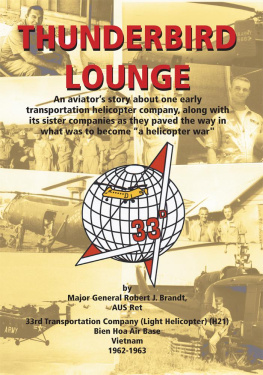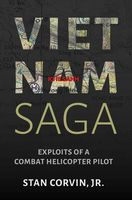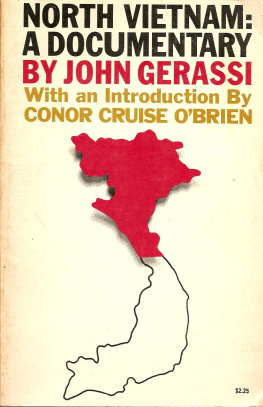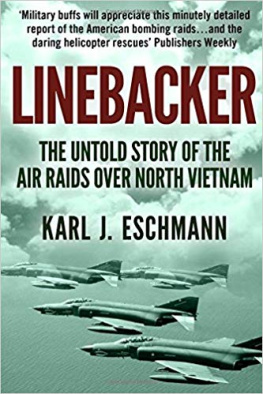Brandt Ed - When Hell was in Session
Here you can read online Brandt Ed - When Hell was in Session full text of the book (entire story) in english for free. Download pdf and epub, get meaning, cover and reviews about this ebook. City: Lake Wylie;S.C, year: 1982;1975, publisher: WND Books;Robert E. Hooper & Assoc, genre: Non-fiction. Description of the work, (preface) as well as reviews are available. Best literature library LitArk.com created for fans of good reading and offers a wide selection of genres:
Romance novel
Science fiction
Adventure
Detective
Science
History
Home and family
Prose
Art
Politics
Computer
Non-fiction
Religion
Business
Children
Humor
Choose a favorite category and find really read worthwhile books. Enjoy immersion in the world of imagination, feel the emotions of the characters or learn something new for yourself, make an fascinating discovery.

- Book:When Hell was in Session
- Author:
- Publisher:WND Books;Robert E. Hooper & Assoc
- Genre:
- Year:1982;1975
- City:Lake Wylie;S.C
- Rating:4 / 5
- Favourites:Add to favourites
- Your mark:
- 80
- 1
- 2
- 3
- 4
- 5
When Hell was in Session: summary, description and annotation
We offer to read an annotation, description, summary or preface (depends on what the author of the book "When Hell was in Session" wrote himself). If you haven't found the necessary information about the book — write in the comments, we will try to find it.
When Hell was in Session — read online for free the complete book (whole text) full work
Below is the text of the book, divided by pages. System saving the place of the last page read, allows you to conveniently read the book "When Hell was in Session" online for free, without having to search again every time where you left off. Put a bookmark, and you can go to the page where you finished reading at any time.
Font size:
Interval:
Bookmark:
WHEN HELL WAS IN SESSION

ADMIRAL JEREMIAH A. DENTON

WHEN HELL WAS IN SESSION
WND Books
Published by WorldNetDaily
Washington, D.C.
Copyright 1975, 1976, 1982, 1997, 1998
by Admiral Jeremiah A. Denton, Jr., and Edwin H. Brandt
All rights reserved. Seventh edition, first printing.
No part of this book may be reproduced in any form or by any means, electronic,
mechanical, photocopying, scanning, or otherwise, without permission in writing from
the publisher, except by a reviewer who may quote brief passages in a review.
Library of Congress Cataloging-in-Publication Data
Denton, Jeremiah A.
When hell was in session.
1. Vietnamese Conflict, 1961-1975-Prisoner and prisons, North Vietnamese.
2. Vietnamese Conflict, 1961-1975-Personal narratives, American.
3. Denton, Jeremiah A. Brandt, Ed, joint author. IITitle.
DS559.4.D46 959.70437 76--18981
ISBN0-935280-00-6
Jacket design by Linda Daly
WND Books are distributed to the trade by:
Midpoint Trade Books, 27 West 20th Street, Suite 1102, New York, NY 10011
WND Books are available at special discounts for bulk purchases. WND Books, Inc.
also publishes books in electronic formats. For more information call (310) 961-4170
or visit www.wndbooks.com .
ISBN 13-Digit: 9781935071150
ISBN 10-Digit: 1935071157
E-Book ISBN 13-Digit: 9781935071693
E-Book ISBN 10-Digit: 1935071696
Library of Congress Control Number: 2009938245

Printed in the United States of America
10 9 8 7
To those who strive to make
this one nation under God,
who are willing to sacrifice to protect her,
who thank God for such great beauty
as she has developed,
and who patiently tolerate her imperfections.
A graduate of the United States Naval Academy, Jeremiah A. Denton served on ships, in many types of aircraft, and as a staff officer during his Navy career. He also served as test pilot, flight instructor, squadron leader, and student at the Armed Forces Staff College and Naval War College, where he received the Presidents Award for the most outstanding masters thesis.
In June of 1965 he began flying combat missions in Vietnam. On July 18, he was shot down during an attack on enemy installations near Thanh Hoa, and spent the next seven and a half years in several North Vietnamese prisoner of war camps.
Promoted to the rank of Captain while imprisoned, Senator Denton provided the first direct evidence of torture by the North Vietnamese. He did so by blinking in Morse Code the word torture during a televised interview.
Upon his release in 1973, Senator Denton demonstrated that long imprisonment had not broken his spirit. Upon landing in the Philippines, he made the following statement:
We are honored to have had the opportunity to serve our country under difficult circumstances. We are profoundlygrateful to our Commander-in-Chief and to our nation for this day.
God bless America.
Since his retirement from active service at the rank of Rear Admiral, Jerry Denton has been active in public affairs. He has especially emphasized the connection between family strength and national morality and the defense of civilization. In 1980, he was elected to the United States Senate from Alabama, where he serves on the Judiciary Committee, the Committee on Labor and Human Resources, and the Armed Services Committee. These committee assignments enable him to pursue the interconnection between moral strength and the security and well-being of our society. In December of 1981, he became Chairman of the Board of United Families of America, a national, grass-roots lobbying group specializing in family issues.
Most of the prisoners of war held by North Vietnam were kept in camps or prisons in and around Hanoi, the best known of which was Hoa Lo Prison, a huge, French-built complex near the center of Hanoi. It was named the Hanoi Hilton by the American prisoners.
There were also the Zoo, Alcatraz, the Plantation, and the Powerplant in or near Hanoi. The Briarpatch, Camp Faith, and Son Tay (also known as Camp Hope) were within about thirty-five miles of Hanoi. The Dogpatch was ninety-five miles north of Hanoi near the Chinese border. There were other camps that were phased in and out at various times.
The Hanoi Hilton was divided into sections and named by the prisoners: New Guy Village, Heartbreak Hotel, Little Vegas (which included the Stardust, Desert Inn, Thunderbird, and Riviera), and, near the end of the imprisonment, Camp Unity. And even these units were subdivided and given names.
Eventually, more than seven hundred prisoners, most of them Air Force and Navy officers, were kept in these camps and prisons. Navy Lieutenant Everett Alvarez, Jr., held the tenure record for a U.S. prisoner. He was shot down in August 1964 and was released in February 1973.
Of course, there were hundreds of prisoners held in camps in South Vietnam, Laos, and Cambodia, living off the jungle in many cases, some confined in bamboo cages, suffering from hunger and disease. Many of them died. Most of the survivors were brought north up the Ho Chi Minh Trail in 1968-69 and 1971 and kept in camps within a thirty-mile radius of Hanoi until the releases began in February 1973.
After the releases, North Vietnam returned the bodies of twenty-three prisoners who had died in captivity. They also notified the United States that they had a twenty-fourth body, but they refused to surrender it, saying the peace agreement stated they had to return only the bodies of men who had died in captivity. Perhaps the twenty-fourth was an airman who had died in the wreckage of his plane; perhaps he was killed by villagers. The North Vietnamese would not say, and the body remains in North Vietnam, unidentified, one of 834 men listed as missing in action.
Communications among the prisoners of war were recognized early by the North Vietnamese as being a vital support to prisoner resistance and morale. Thus, they struck at the communications system constantly.
There were two major codes in use in the prison camps, the Morse code and the tap code. Morse was used early in the imprisonment period, but the tap code eventually became the standard method of communicating.
The Morse code, of course, was well known by most of the prisoners; its modes of transmission varied depending on the circumstances. For instance, a prisoner might tap once on the wall for a dot and thump with his fist for a dash. Or he could give a short whistle for a dot, a longer whistle for a dash. Whistles could also vary in tone: a low whistle for a dot, a higher one for a dash. The same method would be used by scraping with a nail or a broom, or even a fingernail; prisoner hearing became quite acute, and many could detect slight sounds from distant cells.
The tap code actually became the staple form of communication because it was simple and could be sent in a wider variety of situations than the Morse code, which was somewhat faster to send. Getting the tap code to a new prisoner was a top-priority matter.
The tap code is based on the following chart:
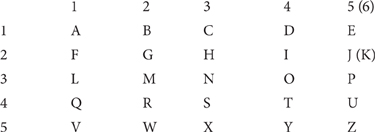
Thus, A is l-l, B is 1-2, H is 2-3, R is 4-2. (The letter K was dropped in order to make the 5-by-5 chart possible. If the letter was needed, it was sent as 2-6.) The numbers could be tapped, waved, scraped, swept, or whatever. The prisoners standardized numerous abbreviations, and with practice, they could send messages quite rapidly.
Next pageFont size:
Interval:
Bookmark:
Similar books «When Hell was in Session»
Look at similar books to When Hell was in Session. We have selected literature similar in name and meaning in the hope of providing readers with more options to find new, interesting, not yet read works.
Discussion, reviews of the book When Hell was in Session and just readers' own opinions. Leave your comments, write what you think about the work, its meaning or the main characters. Specify what exactly you liked and what you didn't like, and why you think so.


